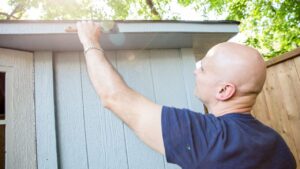Recessed lighting, also known as can lighting, brings a modern, streamlined look to any room. The lights are installed into hollow openings in the ceiling, creating a sleek finish with no hanging fixtures. However, the costs associated with installing these lights can vary significantly.
Installation costs depend on a range of factors – from the type of fixture chosen to the material of the ceiling. It can be challenging to get a clear understanding of how much to set aside for the project without some guidance. So, let’s start by breaking down the basics of recessed lighting, and then we’ll look at the typical cost range for installation in 2025.
What is Recessed Lighting?
Recessed lighting is a type of light fixture that’s installed directly into a hollow area in a ceiling. The result is a light source that appears to have a smooth line with the ceiling, rather than hanging down or mounted on the surface. These lights are popular in both residential and commercial settings because they offer a clean, modern look and can be used to highlight certain areas or features within a room.
Installing recessed lighting involves creating holes in the ceiling, inserting the light fixtures, and wiring them up to the mains electricity. Some people choose to tackle this as a DIY project, but it can be complicated and time-consuming. In most cases, hiring a professional is the safer and more efficient option.
Typical Cost Range For Installing Recessed Lighting in 2025
Based on current trends, it’s projected that the cost to install recessed lighting in 2025 will range from $100 to $500 per light. The difference in cost is generally down to the type of fixture and the complexity of the installation. For example, installing a basic LED light into a drywall ceiling at the low end of the scale could cost around $100. In contrast, a high-end installation involving a premium fixture or a complicated ceiling material could be upwards of $500.

As a homeowner, you’ll generally spend between $100 and $300 per recessed light, with the national average being around $180–$330 per fixture. Some sources cite a higher professional installation cost, $371–$518 per light, for more complex installations or premium fixtures.
However, it’s important to remember that these are just averages. The actual cost can vary depending on many factors, including the region where you live, the number of lights you’re installing, and whether new electrical circuits are required. As such, it’s always a good idea to get a few different quotes before you decide on a lighting contractor.
Understanding these costs and factors can help you make informed decisions as you plan your recessed lighting project. In the next part of this article, we’ll go deeper into the variables that influence the cost of recessed lighting installation, including a breakdown by fixture type and features, as well as labor and wiring considerations.
Factors Influencing The Cost Of Recessed Lighting Installation
When planning to install recessed lighting, it’s essential to understand the variables that may impact the overall cost. The primary factors that influence the cost of installation include the type of ceiling material, labor and wiring expenses, the size of the project, and any necessary permits.
The material of your ceiling can significantly affect the cost. Drywall ceilings, for example, are less expensive to work with than plaster or concrete. The complexity of the construction of your ceiling can also impact the cost. A straightforward ceiling will be less costly to work with compared to a complex or intricate ceiling design.
Labor and wiring costs are another considerable factor. Labor costs can vary depending on the region and the complexity of the wiring needed for the installation. If new electrical circuits are required, this can add to the overall cost.
The size of the project also plays a role in the total cost. Installing multiple fixtures simultaneously can provide some economies of scale, but it will also increase the overall project cost. For instance, installing 4-6 fixtures at once could cost anywhere from $400 to $3,000 in total.
Lastly, permits may be required, especially if new electrical circuits are being added. This could add an extra $50-$500 to the total cost.
Cost Breakdown By Fixture Type & Features
The type of fixture and features you choose for your recessed lighting can also impact the cost. Basic LED fixtures are generally less expensive than specialty features such as dimmable, airtight, or smart lights.
For instance, a basic LED fixture may cost between $15-$30, while IC-rated fixtures, which are designed for direct contact with insulation, range from $20-$50. Dimmable lights, which allow you to adjust the brightness, can cost between $25-$50, while airtight lights, designed to prevent air leakage, may range from $30-$60. If you opt for smart lights, which can be controlled remotely or programmed, you could be looking at $40-$100 per fixture.
However, remember that these are just the costs for the fixtures themselves. The total installed cost, including labor and other expenses, can range from $100-$500 per fixture.
Labor & Wiring Considerations For Recessed Lighting
Labor and wiring are key considerations in the cost of installing recessed lighting. Professional electricians typically charge by the hour, and their rates can vary widely depending on the region where you live and the complexity of the job.
Wiring costs can also vary. If your home is already wired for recessed lighting, the cost will be less than if new wiring needs to be installed. Similarly, if additional electrical circuits are required to handle the load of the new lights, this can add significantly to the cost.
When considering labor and wiring costs, it’s also important to factor in the cost of any necessary permits. In some areas, electrical work requires a permit, and the cost of these permits can add to the total project cost.
To get a better understanding of the potential costs, it can be helpful to get multiple quotes from different contractors. This can give you a range of potential costs and help you budget accordingly for your recessed lighting installation project.
DIY vs. Professional Installation: Pros & Cons
When it comes to installing recessed lighting, you might be tempted to roll up your sleeves and take a DIY approach. But is it worth it? Let’s weigh the pros and cons.
Going the DIY route can save you some money, especially if you’re handy with electrical work. You can control the process and work at your own pace. However, you’ll need to buy your own tools, learn how to safely install the lights, and potentially deal with unexpected issues that arise.
On the other hand, hiring a professional can save you a lot of time and stress. They have the experience and tools to do the job efficiently. Plus, they can handle any surprises that come up. The downside is the higher price tag. It’s up to you to decide which route is best for you.
Additional Costs: Permits & Customizations
When budgeting for recessed lighting installation, don’t forget about additional costs. If you’re adding new electrical circuits, you might need a permit, which could add $50-$500 to your total cost. Also, if you want to customize your lights (like adding dimming capabilities or smart features), this will increase the price.
It’s crucial to factor in these additional costs when planning your project. They can significantly impact your total cost and should be considered when comparing quotes from professionals.
Tips For Budgeting & Getting Accurate Quotes
Planning your budget for a recessed lighting installation project can be tricky. But here are a few tips to help you get started.
First, understand your needs. How many lights do you want to install? What type of lights do you prefer? Do you want any special features? Answering these questions will help you get a better idea of what your project will cost.
Next, get multiple quotes from professionals. This will give you a range of potential costs and help you find the best deal. But remember, the cheapest quote isn’t always the best. Be sure to consider the professional’s experience and reviews as well.
Finally, don’t forget to factor in additional costs like permits and customizations. These can add up quickly and should be included in your budget.
Conclusion
Installing recessed lighting in your home can be a great way to update your space and increase its functionality. However, it’s not a small investment, and understanding the costs involved is crucial.
Whether you choose to tackle the project yourself or hire a professional, being well-informed about the process and costs involved will help you make the best decision for your home and budget.
Recessed lighting can add a modern, streamlined look to any room. With the right planning and budgeting, it can be a worthwhile investment that enhances your home’s aesthetics and functionality.






